
How to promote predatory insects
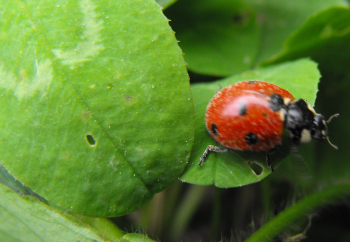 One group of
wholly-positive garden invertebrates is the bugs who consume bad insects.
Spiders, centipedes, dragonflies, mantids (aka praying mantises),
ambush bugs, assassin bugs, lacewings, ladybird beetles (aka ladybugs),
ground beetles, true wasps, digger wasps, hoverflies, and robber flies
all subsist primarily or entirely on other insects during some stage of
their life cycle.
One group of
wholly-positive garden invertebrates is the bugs who consume bad insects.
Spiders, centipedes, dragonflies, mantids (aka praying mantises),
ambush bugs, assassin bugs, lacewings, ladybird beetles (aka ladybugs),
ground beetles, true wasps, digger wasps, hoverflies, and robber flies
all subsist primarily or entirely on other insects during some stage of
their life cycle.
Although many of the species listed above are generalist predators,
eating whatever ends up 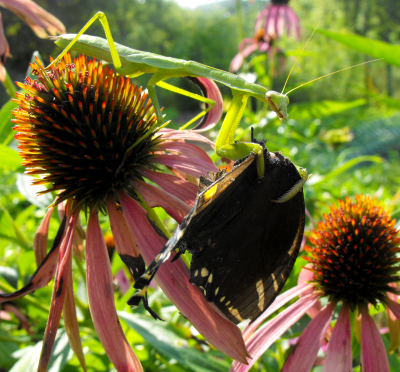 in front of them, all of these insects help keep pest population
explosions in check. For example, I accidentally let the beetles
on my green-bean plants get out of control one summer, and soon
thereafter I saw a pair of praying mantises move in to take advantage of
the bounty. Sure, the mantises might have been eating butterflies
yesterday, but I consider them beneficial insects because they eat at least as
many bad bugs as good.
in front of them, all of these insects help keep pest population
explosions in check. For example, I accidentally let the beetles
on my green-bean plants get out of control one summer, and soon
thereafter I saw a pair of praying mantises move in to take advantage of
the bounty. Sure, the mantises might have been eating butterflies
yesterday, but I consider them beneficial insects because they eat at least as
many bad bugs as good.
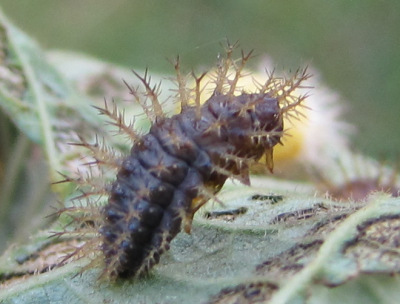 Many gardeners fall in love with the idea of
predatory and parasitic insects and decide to buy some of these critters
to seed their garden. However, I believe that you really need to
encourage all of these species at the ecosystem level. I've heard
of people opening a container of expensive insects, only to have them
all fly away because the garden isn't a hospitable environment for the predators
to live in.
Many gardeners fall in love with the idea of
predatory and parasitic insects and decide to buy some of these critters
to seed their garden. However, I believe that you really need to
encourage all of these species at the ecosystem level. I've heard
of people opening a container of expensive insects, only to have them
all fly away because the garden isn't a hospitable environment for the predators
to live in.
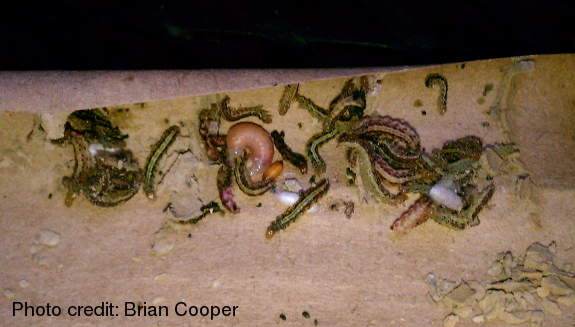
Instead of spending your money on insects, why not
spend a bit of time encouraging the good bugs you already have to stick
around and reproduce? Many depend on flowers during some stage of
their life cycle, so you can encourage them just like you did native
pollinators by ensuring you have copious pollen and nectar sources available
throughout the growing season.
In fact, you might receive double the benefit
from any nest sites you put out for your native pollinators. Brian
Cooper erected mason-bee blocks in his garden, and ended up encouraging
mud daubers by providing wet mud nearby. Brian wrote: "When we went
to
harvest the bees, we found mud daubers also laid eggs in some of the
unused cells. They collect food for their young inside the cell
before
they cap it with mud. I found one cell that was filled with
caterpillars and a dauber larvae, and another cell with a pupa of the
mud dauber and just bug parts left over."
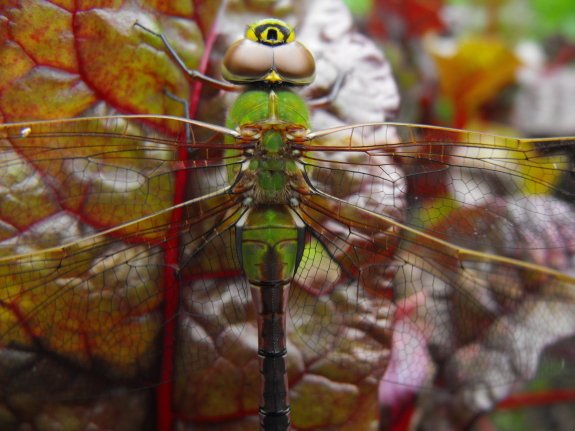
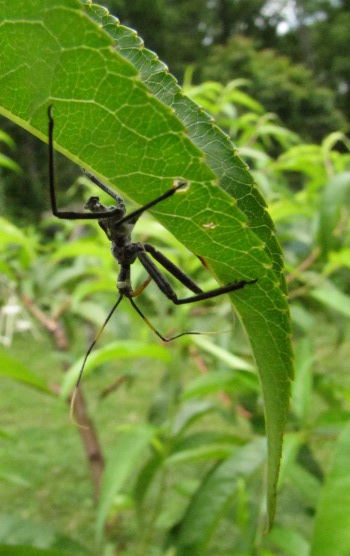 Weedy edges will also encourage predatory insects
since the predators need to be able to find lots of insects to
eat even when your garden pests are under control. In addition,
dragonflies need a pond into which they can lay their eggs, and many
insects will
benefit from having a very shallow body of water from which they can
drink. When attracting predatory insects, it's imperative not to
use any pesticides (even organic ones) and to allow low levels of pest
insects to fly under your radar. If there aren't any bad bugs
around, your predatory insects won't have anything to eat and will go
somewhere else.
Weedy edges will also encourage predatory insects
since the predators need to be able to find lots of insects to
eat even when your garden pests are under control. In addition,
dragonflies need a pond into which they can lay their eggs, and many
insects will
benefit from having a very shallow body of water from which they can
drink. When attracting predatory insects, it's imperative not to
use any pesticides (even organic ones) and to allow low levels of pest
insects to fly under your radar. If there aren't any bad bugs
around, your predatory insects won't have anything to eat and will go
somewhere else.
In fact, you'll probably sense a theme throughout Naturally Bug-Free. To encourage the good bugs, let nature move into your
garden. Leave things alone and the beneficials will come.
I hope you enjoyed this excerpt from Naturally Bug-Free!
If
so, you can download the ebook for $1.99 on Amazon by clicking the link
above. Or just wait for another excerpt tomorrow on the blog.
| This post is part of our Naturally Bug-Free lunchtime series.
Read all of the entries: |
Want more in-depth information? Browse through our books.
Or explore more posts by date or by subject.
About us: Anna Hess and Mark Hamilton spent over a decade living self-sufficiently in the mountains of Virginia before moving north to start over from scratch in the foothills of Ohio. They've experimented with permaculture, no-till gardening, trailersteading, home-based microbusinesses and much more, writing about their adventures in both blogs and books.
Want to be notified when new comments are posted on this page? Click on the RSS button after you add a comment to subscribe to the comment feed, or simply check the box beside "email replies to me" while writing your comment.

Providing habitat for insects is my favorite part of gardening. At my current location, I'm a bit more than 3 years into creating an ecological balance. I garden commercially, but never put any "organic" sprays (no neem, bT, etc.). I am absolutely seeing the benefits now. No major outbreaks as they are quickly mitigated.
My favorite helper plants: yarrow, tansy, parsley, cilantro for the little wasps and hoverflys
borage hedge as a green lacewing nursery. when you get a bunch together it has the added bonus of sounding like a beehive from all the bee activity.
radish flowers, african blue basil, tusli, chamomiles, and any allium flowers
and, surprisingly to me, the absolute best is fennel. Every day, all day the flowers are covered with the most diverse amount of species, including literally dozens of varieties of wasps at one time.
I know I'm forgetting many, but all these are great to include in the garden. Its important to have various types of flowering plants throughout the year. For me, this means letting many naturally adapted plants (weeds) flower, especially in the winter.
Sure,
Not sure if its what you're looking for, but my wife has a few photos on this site http://regenerationatx.tumblr.com/
I haven't been good about taking photos, or posting the ones I have taken. Email me if you are looking for something in particular.